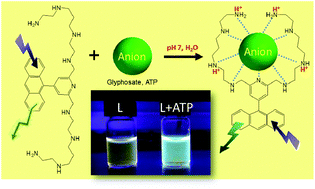A new bis-tetraamine ligand with a chromophoric 4-(9-anthracenyl)-2,6-dimethylpyridinyl linker for glyphosate and ATP sensing†
Abstract
The synthesis of a new linear bis-tetraamine

Maintenance work is planned for Wednesday 1st May 2024 from 9:00am to 11:00am (BST).
During this time, the performance of our website may be affected - searches may run slowly and some pages may be temporarily unavailable. If this happens, please try refreshing your web browser or try waiting two to three minutes before trying again.
We apologise for any inconvenience this might cause and thank you for your patience.
* Corresponding authors
a
Laboratoire de Chimie, Electrochimie Moléculaires et Chimie Analytique, UMR 6521 CNRS/Université de Bretagne Occidentale, 6 Avenue Victor Le Gorgeu, 29238 Brest Cedex 3, France
E-mail:
raphael.tripier@univ-brest.fr
Fax: +00 332 98 01 71 01
Tel: +00 332 98 01 61 38
b Laboratoire d'Ingénierie Moléculaire Appliquée à l'Analyse, UMR 7178 CNRS/Université de Strasbourg, IPHC, ECPM, 25 Rue Becquerel, 67087 Strasbourg Cedex, France
c Laboratoire de Chimie Bioorganique et Médicinale, UMR 7509 CNRS/Université de Strasbourg, ECPM, 25 Rue Becquerel, 67087 Strasbourg Cedex, France
The synthesis of a new linear bis-tetraamine

 Please wait while we load your content...
Something went wrong. Try again?
Please wait while we load your content...
Something went wrong. Try again?
J. Pouessel, S. Abada, N. Le Bris, M. Elhabiri, L. J. Charbonnière and R. Tripier, Dalton Trans., 2013, 42, 4859 DOI: 10.1039/C3DT32325K
To request permission to reproduce material from this article, please go to the Copyright Clearance Center request page.
If you are an author contributing to an RSC publication, you do not need to request permission provided correct acknowledgement is given.
If you are the author of this article, you do not need to request permission to reproduce figures and diagrams provided correct acknowledgement is given. If you want to reproduce the whole article in a third-party publication (excluding your thesis/dissertation for which permission is not required) please go to the Copyright Clearance Center request page.
Read more about how to correctly acknowledge RSC content.
 Fetching data from CrossRef.
Fetching data from CrossRef.
This may take some time to load.
Loading related content
